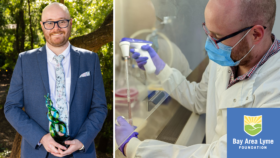FOR IMMEDIATE RELEASE
Bay Area Lyme Foundation ELA Winner Uses Metabolic Modeling to Predict 77 Unique Drug Targets in Lyme Disease Bacterium
Results will help inform future research and development of new Lyme disease therapeutics
PORTOLA VALLEY, Calif., October 19, 2023—Bay Area Lyme Foundation, a leading sponsor of Lyme disease research in the US, today announced the findings of a study identifying new essential gene and enzyme drug targets in Lyme disease bacterium, which resulted, in-part, from a grant provided to Peter Gwynne, one of Bay Area Lyme Foundation’s 2022 Emerging Leader Award (ELA) winners. Published in the peer-reviewed journal mSystems, the study uses the most comprehensive metabolic modeling to date to predict 77 unique drug targets in Borrelia burgdorferi, the bacterium that causes Lyme disease—a condition affecting nearly 500,000 new patients annually.
“Lyme disease is often treated using long courses of antibiotics, which can cause side effects for patients and risks the evolution of antimicrobial resistance. Our research supplies the blueprint and scaffolding to build better Lyme disease therapeutics that do not have off-target effects for patients,” said Peter Gwynne, PhD, lead author on the study, research assistant professor at Tufts University School of Medicine, and Emerging Leader Award winner of the Bay Area Lyme Foundation. “Many of the 77 genes and enzymes predicted as essential represent candidate targets for the development of novel antiborrelial drug development.”
Current clinical guidelines recommend treatment of Lyme borreliosis with broad-spectrum antibiotics, which can pose risks to the patient’s microbiome. The bacterium that causes Lyme disease is extremely host-dependent, with a small genome and limited metabolism—making it an excellent candidate for the development of targeted, narrow-spectrum antimicrobials.
In the study, the researchers used in silico genome-scale metabolic computer modeling to construct a map of B. burgdorferi metabolism. This map was used to predict essential genes and enzymes that can be used as drug targets. Gwynne and the Tufts University School of Medicine research team validated these targets by repurposing existing drugs that kill B. burgdorferi in culture. While these drugs are not viable treatment options themselves, they provide a blueprint for future novel drug development.
